Sciatica Exercises: The 4 Best Exercises
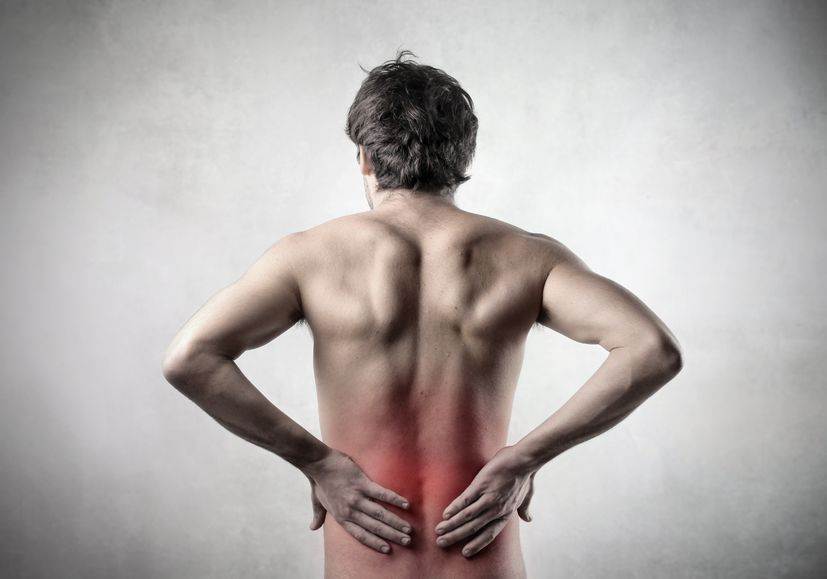
Discover the Best Sciatica Exercises for Pain Relief and Recovery
Persistent sciatica pain can transform daily activities into daunting tasks, leaving you searching for relief. If you’re on the hunt for effective strategies to alleviate sciatica and bolster your rehabilitation, welcome to your comprehensive guide. Here, we delve into not only the treatment options but also spotlight sciatica exercises that are crucial for pain relief and recovery. These exercises, when integrated with the professional care from your chiropractor or physiotherapist, are designed to reduce sciatica symptoms significantly.
Why Focus on Sciatica Exercises?
Exercises specifically tailored for sciatica play a pivotal role in managing and reducing pain. They are essential for strengthening the muscles supporting your spine, improving flexibility, and promoting healthy circulation to the affected nerve regions. This guide is your go-to resource for understanding how targeted exercises can complement medical treatments and accelerate your journey to relief and rehabilitation.
Understanding Sciatica: Sciatica Exercises
Sciatica is often described as a painful sensation that originates in the lower back or buttock, extending down through the thigh and leg, and occasionally reaching the foot. This discomfort results from the compression or irritation of the sciatic nerve. However, the root cause of this pinching can vary, necessitating precise diagnosis and tailored treatment plans.
The Complexity of Sciatica Causes: Sciatica Exercises
Identifying the exact source of sciatica is crucial, as nerve compression can occur at multiple points along its path. Misdiagnosis or oversimplification of your condition as merely “sciatica” without further investigation can lead to ineffective treatment strategies. It’s essential to understand whether the pain stems from issues like disc herniation, degenerative disc disease, or another underlying cause to ensure the appropriate therapeutic approach is employed.
See Also: Best Toronto Chiropractor: How To Find The Best Chiropractor In Your City
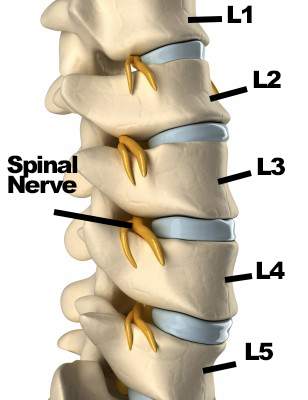
L4 and L5: Sciatica Exercises
So how do I know where my pinched nerve is? Two nerves come out between the last two vertebrae in your body. Your nerve is very commonly pinched here.
Your lower back vertebrae are called lumbar vertebrae. There are 5 vertebrae in the lower back. Taking the “L” for the lumbar spine, they are named L1, L2, L3, L4, and L5. The last two vertebrae in your lower back are L4 and L5.
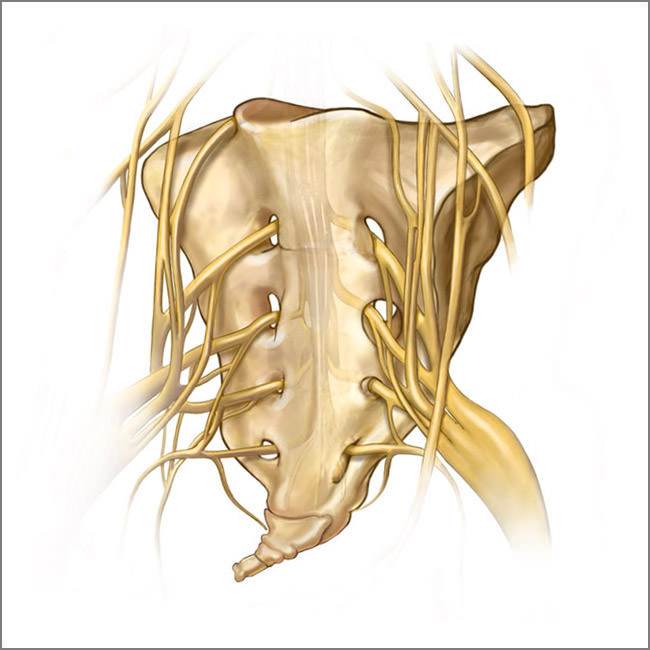
Ion medical designs http://www.ionmedicaldesigns.com/ion_site/two_dimensional_artwork.html
Just below L5 is one of your pelvic bones. It’s called the sacrum. The sacrum has holes with yellow-coloured nerves coming out.
S1, S2, S3: Sciatica Exercises
The nerves are called S1, S2 and S3. “S” is for sacrum. These nerves are rarely pinched.
Your sciatic nerve is formed when the nerves from L4 L5 and L5 S1 join together with the S1, S2 and S3 nerves in your buttock.
So, most of you will have your nerve pinched in one of three spots.
- In the buttock the Sciatic Nerve starts, in other words where the S1, S2, and S3 nerves join the two other nerves that come out between L4, L5 and L5 S1.
- Between L4 and L5 vertebrae
- Between L5 and S1 vertebrae
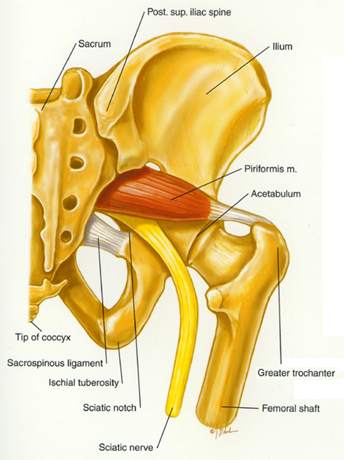
Now you know where the nerve can be pinched but it doesn’t answer why one of the nerves is pinched causing your sciatica
The Usual Suspects (Causes) of Sciatica
Most people’s sciatica is from:
- Herniated Disc at L45 or Herniated Disc at L5S1 (some osteoarthritis = “wear and tear” is involved)
- Degenerative Disc Disease (Osteoarthritis of the Disc=”Wear and Tear” of the Disc)
- Stenosis (Basically advanced osteoarthritis)
- Spondylolisthesis (A fracture of the vertebra or Osteoarthritis with the vertebra moving forward)
- Piriformis Syndrome
These are the diagnoses that your doctor or chiropractor should be telling you about not sciatica.
Remember sciatica only says that you have a pinched sciatic nerve causing pain in your buttock and leg, sciatica doesn’t tell you the cause of your pain. Without determining the cause you will get hit-or-miss treatments from your chiropractor or physiotherapist as they can’t give you specific treatment.
See Also: MRI CT scans X-rays, What’s Best For My Pain
The key exam that you need to determine what the heck is causing your pain is a neurological examination. You have probably seen it on TV before.
- Reflex tests with a reflex hammer on your knee and the back of your ankle
- Muscle Strength Testing: Resisted muscle testing of your foot. You try and push up/down while the chiropractor holds your foot. An alternative is heel walking and walking on your toes.
- Light Touch and Sharp Dull Testing: A light touch directly on the unclothed legs and feet to determine if you are unequal in your sensitivity to light touch and sharp/dull testing. A light touch is often enough as a screening.
Also, remember that the diagnosis should pretty much be determined in the office and X-rays, MRI, and CT scans done only if there are signs of something else or the diagnosis is kind of fuzzy.
See Also: Herniated Disc Part 2: The Best Exercises For Your Herniated Disc
Herniated Disc: Sciatica Exercises
You herniate a disc from the everyday habits that you have. The everyday habits of slouching and bending with a rounded low back, build up to weaken and damage the disc to the point it is ready to break open and herniate.
The problem is there is no pain. You don’t feel sciatica until the disc has herniated as there are no nerves inside the disc. So you continue your habits and think you don’t have a bad back until one day you lift your daughter off the floor.
The only problem is you had a bad back with no symptoms for a very long time. This is just like a car with a little bit of rust showing but if you take the car apart you see a lot more rust.
Degenerative Disc Disease – Osteoarthritis of the Disc
Degenerative Disc Disease is a continuation of the breakdown of the disc that was started by bad lifting and slouching habits.
The disc becomes smaller, and brittle like an old elastic band that is decaying, leading to the disc becoming smaller in height. The smaller disc makes the space between the vertebrae smaller. Thus, your nerve doesn’t have much room, so your nerve gets pinched between L4 and L5 or L5 and S1.
Stenosis- Most commonly from continuation of Osteoarthritis
Stenosis is a “narrowing”. There are two types of stenosis
- Lateral Stenosis
- Spinal Stenosis
1. Lateral Stenosis is the narrowing of the hole which the nerves from the spinal cord come from. Does this sound familiar? It’s degenerative disc disease + the bone degenerating forming spurs that narrow the hole for the nerve. A smaller hole for your nerve eventually means a pinched nerve.
2. Spinal Stenosis is the narrowing of the canal where the spinal cord sits. This is essentially pinching of the spinal cord usually in the lower back.
Spondylolisthesis (Vertebebra moving forward)
Spondylolisthesis is usually the moving forward of the vertebra (sometimes backwards). When the vertebra moves forward the spinal cord and nerves are pulled putting tension on your nerve. Nerves under tension get irritated and so turn into sciatica. This can happen from a fracture to the vertebrae or osteoarthritis.
Piriformis Syndrome
Most people’s sciatic nerve usually goes over or under the piriformis muscle. In some cases, possibly yours, the sciatic nerve goes right through the piriformis muscle. When the muscle tightens up it squeezes on the sciatic nerve causing sciatica.
Walking like a “man” is another reason for sciatica. That’s right, when you walk bow-legged with your feet turned can give you trouble later.
Chances are, if you are reading this you already have a problem with sciatica. When you turn your feet out this makes the piriformis muscles work harder.
The harder your piriformis works the more likely the nerve will be pinched causing sciatica.
The 4 Best Exercises For Sciatica
While treatments are different for sciatica depending on the cause you can still help your chiropractor or physiotherapist by doing your home exercises.
1. Flossing: first introduced by Michael Shacklock
Flossing is good for your teeth but a different kind of flossing is good for your spine and spinal hygiene.
First, determine if you can floss safely:
- Sit on a chair or relatively hard surface. Please don’t sit on the couch, it is too soft and will aggravate your lower back.
- Raise your painful leg to the point of pain and keep it there.
- Bend your neck forward till your pain is aggravated from above
- Lower the leg till the pain decreases.
If the pain decreases you are safe to do flossing.
Warning: This exercise can cause acute sciatica but chances are minimized by doing the screening exercise. Don’t floss until you have been out of bed for at least 2 hours. Now The Flossing:
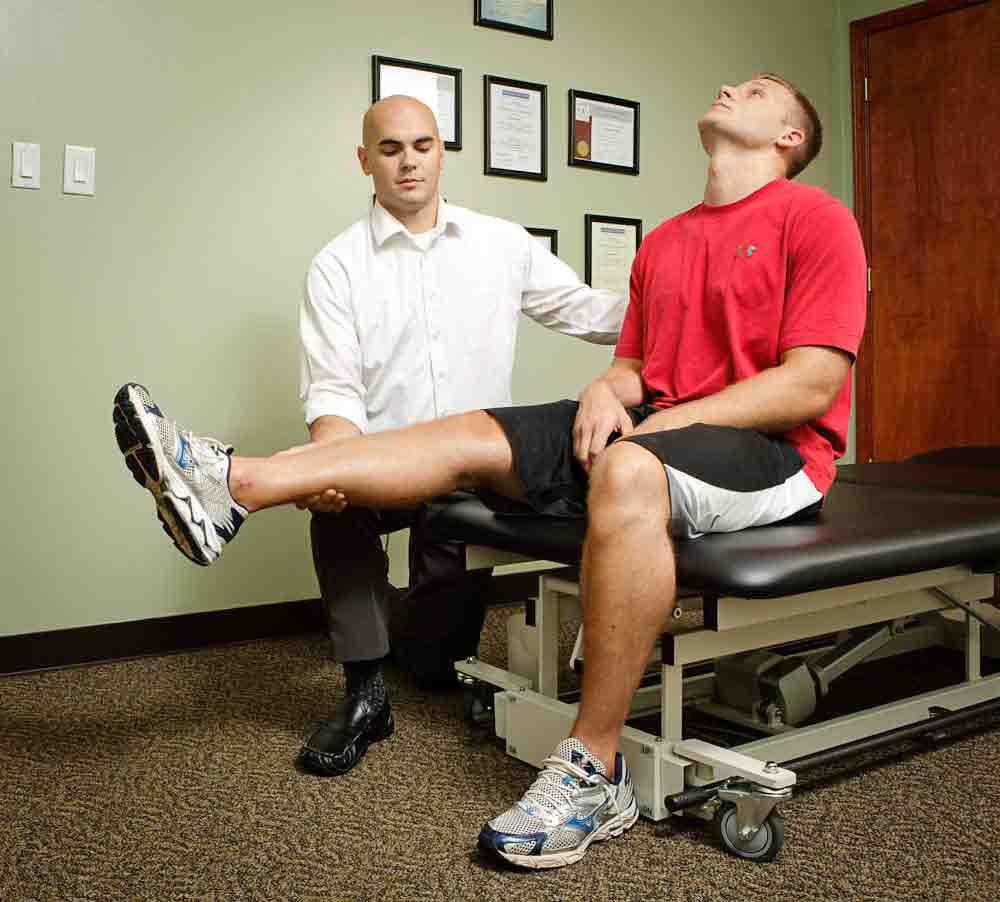
- Sit down in a chair with your legs swinging freely
- Bend your neck forward for 5 seconds (if this doesn’t cause sciatica you can do the next step)
- Bend your neck backwards as far as possible and straighten the knee (5 seconds)
- Repeat 3 sets of 10X on each leg. You can do this for up to 5/day.
2. Piriformis Stretch A) Sitting and B) Lying Face-Up
A: Sitting:
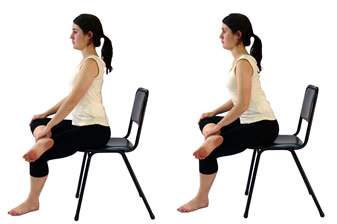
- Sit in a chair and cross the bad leg over the good
- Keep the arch in your back and move your chest forward
- Repeat 3 sets 30 secs. This can be done several times a day
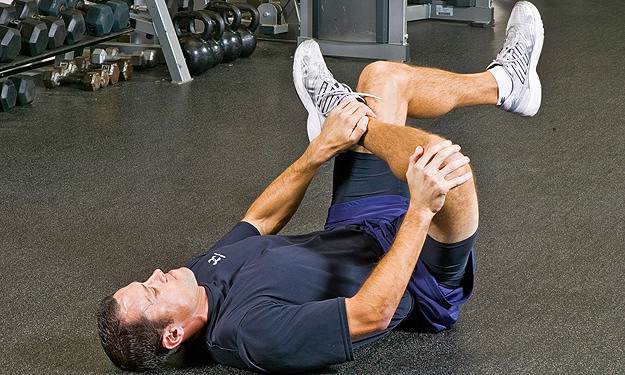
B: Lying Face-up: This exercise might be easier for some of you.
- Lying Face-up both knees bent. Put the bad leg over the good.
- Bring the good leg up to support the bad leg.
- Push the bad leg outward.
3. Ball Exercises: Piriformis, Gluteus Maximus, Gluteus Medius
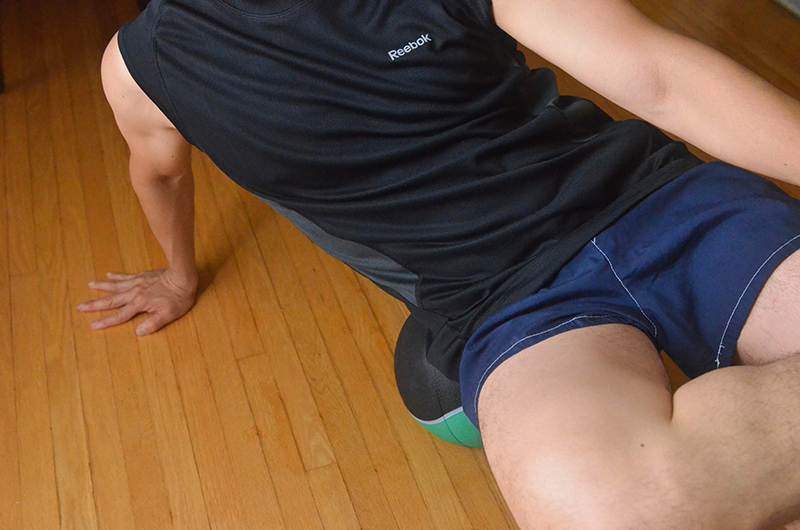
Piriformis
- Cross your bad side leg over the other knee
- Get a tennis ball, basketball or a medicine ball and sit on it with your buttock.
- To treat the piriformis go lean at about a 45-degree angle.
- Stop at each tender point and hold until each one is ironed out or feels less tender.
Gluteus Maximus
- Same as the piriformis except that you don’t need to cross the bad over the good.
Gluteus Medius
- Same as Gluteus Maximus except that you now lean at almost a 90-degree angle -You are almost on your side with a focus on the side area just below the belt or hip bone
4. Cobra
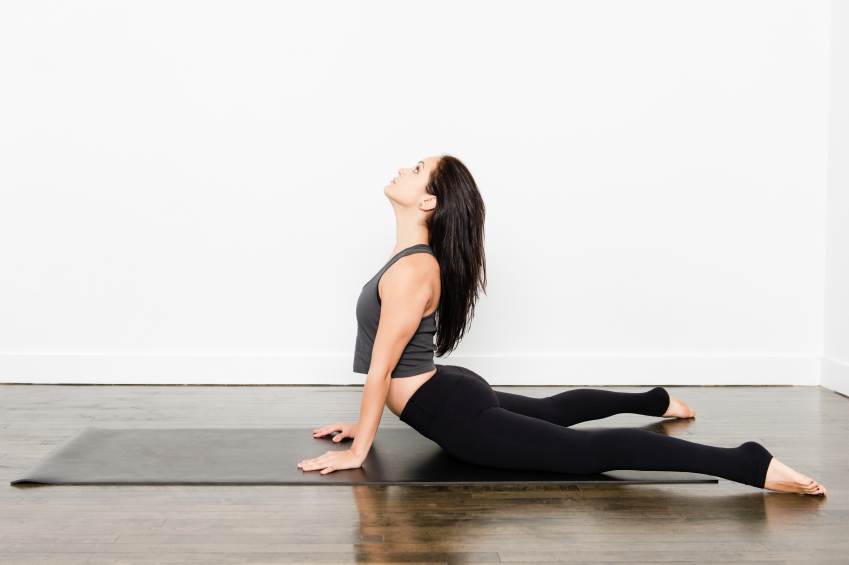
- Lie down face down with your hands underneath your shoulders.
- Push up from as high as you can until your lower back stops you or your elbows are straight.
- The pelvis should still be on the floor and the lower back muscles relaxed.
- Do these exercises hold each time for 1-2 seconds 6-8 times per set? This exercise can be repeated every two hours throughout the day.
If your pain is from a disc herniation you can combine the disc herniations part 2 exercises with these exercises. If your sciatica is from a different cause I will write about all the conditions that cause sciatica over time.
Write in the comments to tell us how you are doing with your sciatica. Also, let us know your vote for the best Toronto Chiropractor below. Connect with me on LinkedIn.


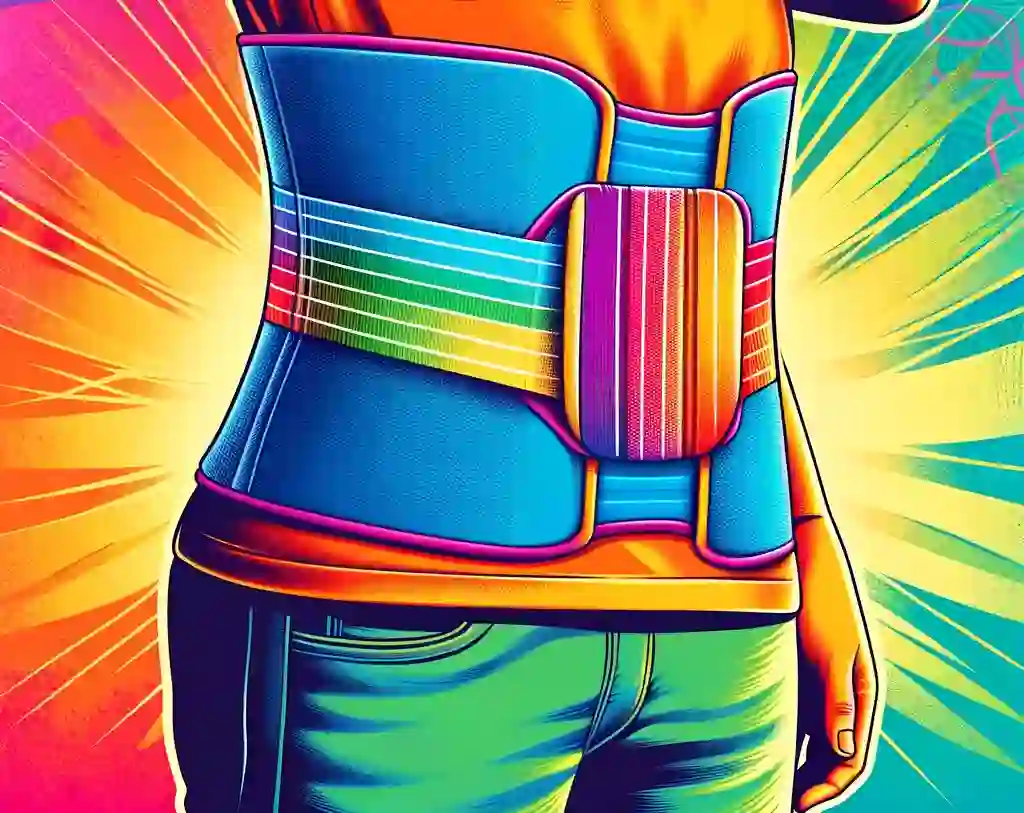
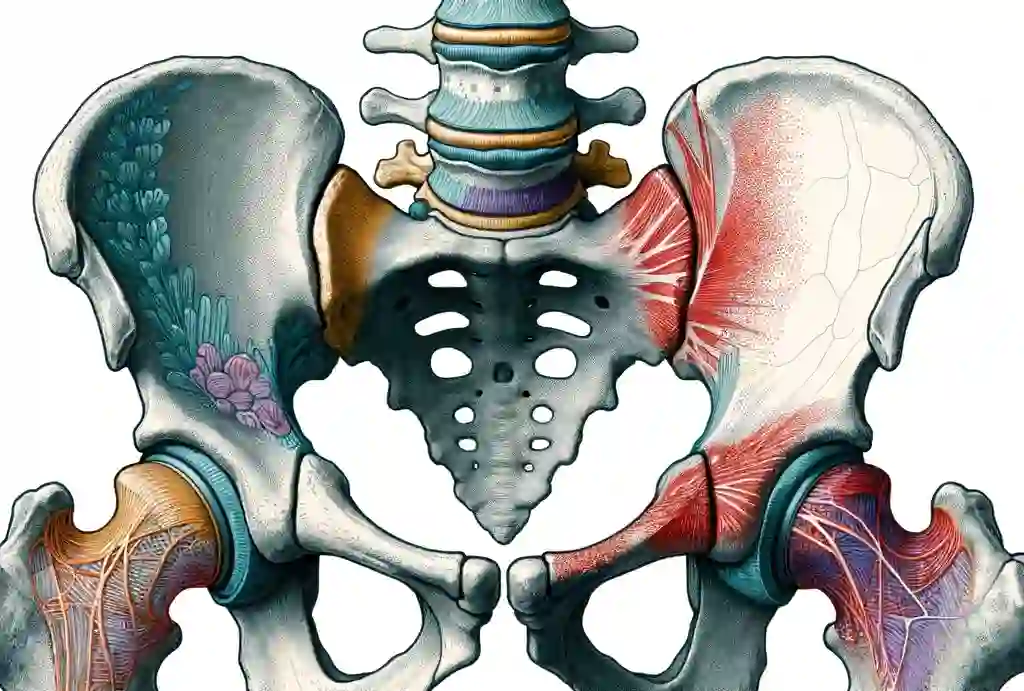
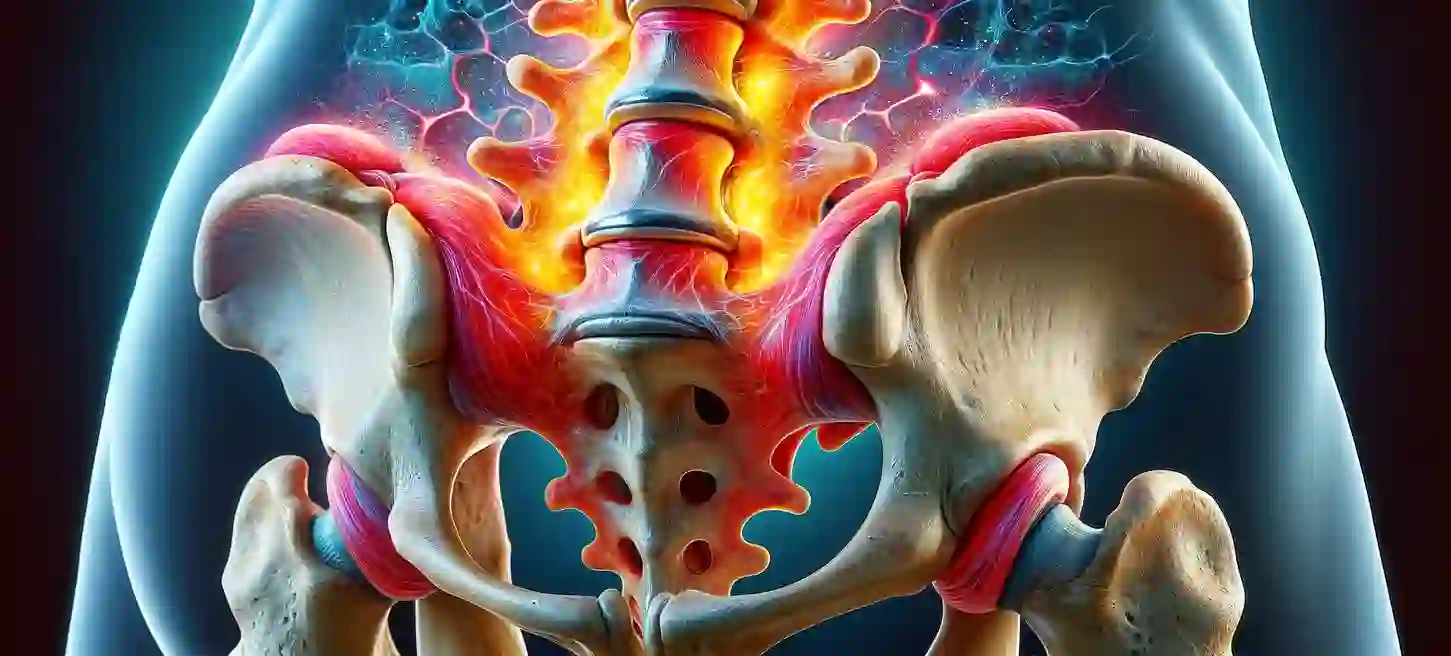
L5 S1 Disc Sequestration- one of reasons is improper and stressful life and Gym in such situations or Traumatic incidents. The weight you carry, 70% is taken by your muscles and only 30% by bones. With Stress and physical weight, your nerves go weaker and needs to be managed well. And if sequestration is more, the disc semi liquid may fall on your leg nerves, which will carry pain to your left or right leg creating numbness or tingling sensation.
Solution:
Important: Morning sunlight act as building block, expose at-least 60% of your body to morning sunlight for half an hour(mainly the back portion)
1. Take proper rest everyday and if pain is unbearable take complete bed rest (approx 3–4 weeks, till you feel better) . Pain killers initially is fine, but don’t continue for long, as it may damage internal organs.
Drink lot of fluids(water) to reduce gastric issues.
2. Go for physiotherapy, till the pain is relieved and you understand what exercises is suitable for your body to subside the pain. Here exercises mean not lifting weights or crunches etc.(**Please avoid gym** for at-least a year or more)
.
3. Keep doing yoga or back stretching exercises as suggested by physiotherapist. Therapies like** IFT and Ultrasound help to relieve strain**.
4. light weight oil massage on back will help gain temporary relief. Don’t put heavy pressure, it may generate strain.
5. Don’t sit for long hours, keep walking(but avoid walking on roads, use footpath). Sitting postures should be learnt. your legs should be leant forward when sitting and dont cross the legs.
6. Eat a lot of proteins rich food like Almonds, eggs, fish etc. It will help build muscles, but yoga and exercises are important.
Note: Your whole body goes weaker with spine related injury, take each physical action with care.
Author
Thanks for your comment Sachin. “IFT” or really IFC doesn’t help neither does ultrasound. The research has thoroughly dismissed those therapies. Also, I treat many Yoga people and numerous yoga teachers as it causes back problems. Pilates is much better. Also, chiropractic is very helpful not just physiotherapy often more so than physiotherapy but it does depend on the experience of the professional. More protein and more muscle don’t help the back. It’s the stability of the muscles as long as you have a minimum threshold of muscles.
Hope that helps your sciatica. If you have any more questions for this downtown Toronto chiropractor I will do my best to give you a helpful opinion as possible.
Hi,
I am Pratibha I am suffering from backache for last 4yrs I have done my MRI which says as mild posterior angular buldge of L3-4 intending the interior the anterior thecal sac and bilateral traversing L3 nerve roots can u plz guide what to be done to get back into a pain free life. Kindly guide the same.
I would be grateful.
Author
Thanks for your question Pratibha. You need to write 2-3 paragraphs like you wrote but about your symptoms not about your MRI. Otherwise, I cannot comment.
Hope that helps your Sciatica.
hello sir, I am from Malaysia. 23 years old and working as a warehouseman in oil and gas group. I am suffering with pain in back and leg about 6-7 years ago. based on my MRI reports, “At L4/5, there is circumferential disc protrusion causing descending nerves roots impingement. both neural foramens are not compromised. both exiting nerve roots to L4 are sparred. both lateral recesses are narrowed. spinal canal measures 10mm in AP diameter. there is ligamentum flavum hypertrophy but no facet joints arthropathy.”
“At L5/S1,there is circumferential disc protrusion causing descending nerve roots impingement(L>R). both neural foramens are not compromised. both exiting nerve roots to L5 are sparred. both lateral recesses are narrowed. spinal canal measures 4mm in AP diameter. there is ligamentum flavum hypertrophy but no facet joints arthropathy”. I have been suggested to do an operation to replace with silicone. do you any suggestion to do some exercise to avoid surgery or operation. thanks.
Author
Thanks for your question Idzham. https://www.bodiempowerment.com/herniated-disc-part-2-the-best-exercises-for-your-herniated-disc/
You may be able to do these but just to warn you will likely get worse so they have to be supervised by a health care practitioner in your area. Medical doctors are not trained in rehab and the vast majority are not familiar with these exercises so they do not qualify. A great chiropractor or a great physiotherapist that comes recommended would be a good choice. This is an opinion and not a recommendation.
Hope that helps your L4/L5 L5/S1 disc herniations.
Sir
I was diagnosed with diffused annular disc bulge extending into bilateral neural foramen at L4-L5 level with impresion on thecal sac and bilateral traversing nerver roots.
Underwernt 2 weeks of physio and continuing the exercises
There was tingling pain behind the thighs and burning sensation in the foot…Over the past two months these have substantially reduced. But i am facing cramps in hip and pain in things and ankle.
Please advise
Author
Thanks for your question Muthu. The physios should work on your legs, thighs and hip where you have the cramp. That’s just my opinion.
Hope that help your sciatica.
Thanks Dr Ken.. I am due for the doc visit tomorrow. Will bring up this issue with him. On the other hand i am visited by the physio every weekend and he is seeing improvement. Hopefully by continuing the exercises ( which you have listed in your site and proposed by Physio) the condition should improve
Author
Thanks for your comment Muthu. Usually, you do the exercises of the person that can examine you. If you wern’t improving that’s another case, but since you are improving, just follow your physio’s advice.
Hope that helps your sciatica.
Hello Dr Ken Nakamura!
My mother is 63 years old and she’s experiencing pain in her left knee. She undergone MRI and the result is this:
IMPRESSION
-MILD BILATERAL NEUTRAL FORAMEN STENOSIS AT L2/L3.
-POSTERIOR DISC BULGE WITH MODERATE CENTRAL CANAL STENOSIS, MODERATE RIGHT NEURAL FORAMEN STENOSIS AND MODERATE TO SEVERE LEFT NEURAL FORAMEN STENOSIS AT L3/L4.
-CENTRAL POSTERIOR DISC PROTRUSION WITH CENTRAL DURAL SAC INDENTATION, MODERATE TO SEVERE CENTRAL CANAL STENOSIS AND SEVERE BILATERAL NEURAL FORAMEN STENOSIS AT L4/L5.
-SCHMORL’S NODE AT THE SUPERIOR CORTICAL ENDPLATE OF L3 VERTEBRAL BODY.
-OSSEOUS HEMANGIOMA WITHIN L3 VERTEBRAL BODY.
-DISC DESICCATION AT L2/L3, L3/L4 AND L4/L5.
-APPARENT POSTERIOR CONVEXITY WITH VENTRAL DURAL SAC INDENTATION AT C4/C5, C5/C6, T9/T10, T10/T11 AND T11/T12. SUGGEST MRI OF THE CERVICAL AND THORACIC APINE FOR FURTHER EVALUATION IF CLINICALLY INDICATED.
We asked our referring orthopedic about this and he mentioned that this should undergo surgery ASAP. But my mother don’t want any surgery because 1) she’s afraid and 2) financial problem. Will physical therapy possibly treat the situation? Is it possible that it can me cured by physical therapy? Or any alternate ways?
Thanks for your help and God bless.
Author
Thanks for your question Dominique. The question is does anything in lower back cause the knee pain? While there is moderate to severe canal stenosis it doesn’t mean that is the cause. Some people have severe stenosis with no pain. Does the history and exam correlate with the MRI. The MRI is not something you diagnose with; you diagnose with the history and exam and if the MRI confirms the diagnosis then you do conservative therapy.
You don’t say anything about her knee except she has left knee pain, which leads me to think she was likely diagnosed by MRI and that she did not have a proper history and exam of her knee followed by MRI.
Also, why would someone with stenosis have to have surgery ASAP? Stenosis takes decades if not your whole life to develop. Unless there was progressive neurological degeneration not over years but over the last few weeks or days then there is something seriously wrong when “you need surgery ASAP”. You also have to taken into account that is a possible disc herniation in which case the criteria for surgery are:
1. Progressive neurological deterioration like drop foot that is getting worse. Muscle weakness is getting worse over days or weeks again not over years.
2. Saddle anaesthesia, which is numbness or tingling wherever a saddle would touch namely the inside of your thighs and buttock.
3. Urinary retention and loss of bowel control.
Unless she has those and she doesn’t have cancer or other criteria for surgery then the surgery ASAP does not apply.
Was the knee examined and thorough history taken of the knee or was it all assumed? So far there are a lot of things you either haven’t said or simply your health team didn’t do. I don’t know which as you haven’t told me.
All of this is an opinion as I haven’t examined her so is not a recommendation.
Hope that helps your mom’s possible sciatica or possible knee pain.
Hello Dr Ken,
I’m 53 and presently having a bout of sciatica . From too many hours at a deskjob -which I have quit… and several long car trips recently.. No pain just non stop tingling from lumbar through groin, legs, feet to soles of feet…
I had a bout about decade ago that included pain and severe immobility for a week or two but made a full recovery with exercises and a couple of extra weeks time.
2 questions for you Dr. :
1. As there is no pain just tingling and am in good shape overall is it it reasonable to assume that I needn’t have my disc looked at for ruptures etc ?
2. I occasionally / recreationally use small doses of tadalafil (Cialis) (2-4 mg bits) which I understand can trigger ‘crowded disc’ . Is Tadalafil a bad idea in general – assuming that with time and careful diligence in physical therapy my Sciatica will disappear again?
p.s. The exercises you have provided are wonderful and already having a positive effect, and are enjoyable- THANKS!
Author
Thanks for your question Joe. I still think it’s a good idea to have your disc looked at. With tingling though it is possible that your tingling will simply go away over the course of time with no treatment whatsoever. However, it can be a precursor to pain again. What I mean is that you may have tingling, but it might progress to pain, or even numbness which goes further down into the leg or foot.
If your tingling is getting better over time you can just leave it as long as you have no other symptoms. You still need to get tingling checked out by someone that can examine you to see if there is any more severe problem.
As for your question about Tadalafil. This is outside my scope of practice so I will refrain from making any comments.
This entire comment is an opinion and not a recommendation.
Hope that helps your sciatica.
Dr.Ken
I am suffering from low back pain from 15 years and gone treatment for some continues interval.
Now I am finding very severe back pain throughout my leg and foot.cant able to stand 5min/ walk.please go through my last year MRI Report I copied here and numberings as MRI 1.
MRI.1
MRI LUMBO.SACRJA,L SPINE
CLINICAI INFORIT{ATIoN
Low back ache, for evaluation.
PROTOCOL
Sag and ax T1, T2 and sag STIR
FINDINGS
Centro-lateral disc protrusion with obliterating bilateral lateral recesses L4 nerve roots.
o All discs appear.hlpointense on T2wr suggestive of dehydration. ,t
vertebrae show nornal signar intensity. The bodies, transverse and and pedicl6s of a]l the wisuarised vertebrae are normar. No fracture
The facet j::”1″ at alJ. levels are normal.
The conus medulraris terminates at upper endprate of L1 vertebra- theca and sub arachnoid spaces are nornar. Nerve roots are rrormal.
sequences of the lurnbo-sacral spine were performed.
]rrrr,rr”r tear is seen at L4-L5 revel and neural foraminae compressing exiting
sPJ_nous processes
or compression.
The surrounding
Pre and para spinal soft tissues are norroal.
CONCLUSION
Centro-lateral disc protrusion with annular tear Iateral recesses and neural, foraminae compressing
at L4-L5 level obliterating bilateral exiting L4 nerve roots.
Author
Thanks for your question Muraidass. It appears that you may be a surgical candidate. Exercises likely won’t help you. This is an opinion and not a recommendation.
Good luck with your sciatica.
Hi Dr. Nakamura
So happy found your site – a wealth of information. I have a question – been having lateral lower calf and ankle pain and we’re unable to find anything on MRI for the ankle so sent me for MRI of my back because started to have pins and needles ankle. MRI showed herniated disks L4-L5 and L5-S1.
I went to PT which consisted working the peroneal area with ultrasound and then the tens therapy for 30 minutes – along peroneal line – one near lateral knee the other attached to lateral ankle.
In one post you mention only a bad P/T starts with the foot – they should start with the back
Had 4 treatments so far – no help really – should I ask PT for other form of therapy.
Thank you
Author
Thanks for your question Addie. A good chiropractor or good physiotherapist will clear the lower back first, before treating the leg. The exception is during testing if they find movements or exercises that improve the leg. In addition, ultrasound has not been found to be helpful for anything as a therapy in every study of worth so far. In other words, ultrasound isn’t worth the effort for the vast majority of conditions.
I personally would go to another practitioner as they are doing two things wrong with your PT in my opinion. While you might save the cost of initial examination you will save money in the long run as you will get better faster and not have time wasted like, getting ultrasound on your lower back. Again not effective. I don’t have much faith in that particular PT. This is an opinion and not a recommendation.
Hope that helps your sciatica.
Good day dr. Kim its been almost 3 months that ive been suffering from back pain down to the left bottocks down to the thigh , leg and foot ive been having physical theraphy for almost 2 mos but its getting worst. Icant stand or walk for 5 min since the pain is excruciating. My MRI result findings circumferential disc bulge with posterocentral protrusion component L4L5 level indents on the ventral thecal sac with bilateral nueroforaminal narrowing. Broad based posterior disc bulge with left paracentral disc protrusion, L5S1 level, indents on theventral thecal sac with narrowing of the Left lateral recess and nueroforamen, empending on the left exiting L5 and decending S1 nerves, Disc dissicaton changes, L4L5 and L4S1 disc, please help me on what to do thank you very much
Author
Thanks for your question Bethella. First it’s Dr. Ken not Dr. Kim. Sounds like you need to try a different health professional. Just find the best chiropractor or best physiotherapist in your area.
Hope that helps your disc protrusion and sciatica.
Hello
I am having the pain in my back as well as in thigh and in Heel. It increases whenever i do some physical work. Below is my 02 MRI reports in the inerval of 2 years. Earlier i had this problem once in every 2-3 months but now it got permanent so i am worried. This may increased i have started playing badminton from last 7-8 months but now i have left badminton and walking too. But this pain is not going. Seeking your advise for the relief and medicines. I have vitamin D inefficiency too.
MRI report of 2014
Multiplanar MR images of the lumbosacral spine were obtained using T1 and T2 weighted TSE
and FFE sequences. The study reveals normal lordotic curvature of the lumbar spine. Lumbosacral junction
is transitional with partial sacralization of L5 vertebra. The vertebral bodies are otherwise normal in size,
shape, alignment and signal intensity. No osseous destruction is seen. Early degenerative changes are present
in L4L5
intervertebral discs as evidenced reduction in the bright signal intensity of nucleus pulposus on T2weighted
sagittal sections. Mild concentric bulge of L4L5
disc is present indenting thecal sac and mildly
narrowing neural foramina. The bony central lumbar canal is adequate in diameter with no evidence of
primary stenosis. The lower end of the spinal cord, conus medullaris and nerve roots of the cauda equina are
normal. The thecal sac is normal and CSF demonstrates normal signal intensity. No intraspinal mass or
pre/paravertebral collection is seen. IMPRESSION: MRI LUMBOSACRAL SPINE FINDINGS ARE
SUGGESTIVE OF: EARLY
DISC DESSICATION WITH MILD DIFFUSE BULGE OF L4L5
INTERVERTEBRAL DISC
MRI report of 2016
Multiplanar MR images of the lumbar spine were obtained using T1 and T2 weighted TSE and
FFE sequences. The lumbar and lower dorsal vertebrae are normal in height, alignment and marrow signal
characteristics. There are mild generalised degenerative spondylotic changes in the lumbar and lower dorsal
spine with marginal end plate osteophytes and degenerated intervertebral discs displaying hypointense signal
on T2 weighted images involving L3L4
and L4L5
disc. The L3L4
and L4L5
discs shows focal tear with
diffuse annular bulges indenting over the thecal sac with mild bilateral foraminal compromise. No overt signs
of compression of exiting nerve roots are seen. The rest of the lumbar discs are normal in height and signal
intensity. No significant disc herniation is seen in the rest of the lumbar spine causing thecal sac indentation
or foraminal narrowing. The exiting nerve roots in the lumbar region otherwise appear normal. No evidence
of developmental bony spinal canal stenosis is seen on this study. Pre & paravertebral soft tissues are within
normal limits. Conus is normal in position and signal intensity. STIR coronal sections of the sacroiliac joints
do not show any definite abnormality. Screening study of cervicodorsal
spine do not show any definite
demonstrable abnormality. IMPRESSION: There are mild changes of vertebral spondylosis with
degenerative disc disease involving the L3L4
and L4L5
discs levels as mentioned above. Clinical
correlation would be necessary.
Author
Thanks for your query Raskesh. Your First MRI mentions sacralization and your second one doesn’t. This means the second radiologist missed this on the report. Notwithstanding this you could try these exercises here in this article and here: https://www.bodiempowerment.com/herniated-disc-part-2-the-best-exercises-for-your-herniated-disc/
Keep in mind that any exercise can make you worse. It is much better to have a health professional like a chiropractor or physiotherapist guide you. You should not do these exercises without professional guidance as the chances are that you will get worse. Just find yourself the best chiropractor in your neighbourhood.
Hope that helps your hernieated disc.
Hi Doctor,
I’ve multiple issues with my back as shown in MRI. There’s a grade1 spondylolisthesis at L4/L5 of 2 mm and disc bulging and degenerative changes within the facet joints predominantly on the right side.
There’s disc dessication at L5/S1. There’s a shallow posterior bulging which abuts the origin of the right S1 nerve root. Mild degenerative changes within the facet joints.
At L3/L4 there’s mild degenerative changes within the facet joints.
There’s no significant central canal stenosis and no significant central canal, lateral recess or neural foraminal narrowing.
The pain started some 6 months ago and I thought it to be muscular as it affected my left leg mostly. I couldn’t climb stairs with my left foot as a lead. The pain travelled down buttocks, hips, thigh and around groin. Soon back and right leg started getting affected. First got X-ray and then MRI done.
I’ve been going for PT but it didn’t help. Now I’m doing Acupuncture – had 3 sessions, yet to see some result. I work full time and try to take breaks after sitting for long. I can’t stand or walk for more than 15 – 20 minutes. Sitting is not so bad but when I get up, I limp and back hurts a lot. I use heat pack when it hurts too much.
I’m doing some stretches as advised during PT. It feels good to do pelvic tilt and bringing knees to chest. Can’t sleep well as I’m a side sleeper and legs hurt terribly thigh down to my heels. I’ve not been given any explanation as to what is causing the pain – is it spondylolisthesis or bulging discs causing nerve compress/pain.
Please help.
Author
Thanks for your question Ringo. If you don’t see results within 8 visits than you should stop going and find someone else. I think 8 visits gives a fair amount of treatments including different treatment methods that the physiotherapist can try. No results then find yourself the best chiropractor in your neighbourhood. The most likely diagnosis is a disc pinching on the S1 nerve.
That’s my opinion not a recommendation.
Hope that helps your sciatica.
Hi have a broad based building disc between l4-5 si . Was getting better inPT, than got worse. Stopped now back inPT , mostly having electric jolt pain on bottom of foot . Very minimal leg pain and back. Could I have a bone spur in foot too? Can you reccommend any exercises that will get rid of the foot pain?
Author
Thanks for your question Bethany. Yes, your foot can be the source of your pain but it’s best to rule out the lower back first. A bad PT will actually start in the foot. You always have to rule out the lower back, once that’s cleared within two or three sessions you can treat the foot.
As for actually treating your foot, like I said that is premature as you need to give your PT time to clear your lower back or rule it out as the source of the foot pain. That’s my opinion, not a recommendation.
Hope that helps your sciatica.
Hello sir, my MRI report shows (posterocentral bulge of l4/5 disc thecal sac) . Sir in my hands and legs so much tingling and numbness.plz give me some exercise and tell me can I recover 100%?
Author
Thanks for your question Faiz. You need to tell me a lot more detail about your symptoms for me to give you an opinion.
Hope that helps your sciatica.
Hello.
1 year ago I was sitting at a red light and was hit from behind at 40 mph. I was pushed into the vehicle in front of mine. The MRI’s showed 2mm disc bulge at c3-c4 and 3mm retrolisthesis and 3.5mm herniation with abutment of cervical spinal cord at c5-c6. My lumbar MRI showed 3mm bulge with bilateral facet joint effusions at L4-5 and 2.5mm bulge with annular tearing at L5-S1. My lower back hurts constantly. It goes down my left leg. I cannot bend all of my toes on my left foot. I was sent for injections and the only improvement was, when laying on my back i could lift both legs together, which i could not do prior to the injections. My neurosurgeon says the lumbar findings are nothings to be concerned about but clearly something is wrong. What could be the cause of this constant pain. Its a deep ache. Its worse when just standing in place. Any insight would be GREATLY appreciated.
Author
Thanks for your question Fiona. Sound like the 2.5mm bulge with tear at L5S1 is the likely tear. If that is the case you can do these exercises.
https://www.bodiempowerment.com/herniated-disc-part-2-the-best-exercises-for-your-herniated-disc/
However like any exercise they can make you worse. If the pain, numbness or tingling goes further down the leg then you are getting worse so you should stop the exercises immediately.
The above is an opinion and not a recommendation.
Hope that helps your possible disc herniation.
Thank you so much for your reply
Author
You are welcome Fiona.
Hi Dr Ken, I’d like to ask for some advice regarding exercises. I am 33yo, up until a few weeks ago i have been active with weight-training/cardio 3 times a week. For the past few weeks I’ve been having lower back pain mainly on the left side and radiating down to my left leg to my last 2 toes. Went to see a neurosurgeon and wAs told that i like have s1 radiculopathy. I am waiting for my mri appointment (which is in a months time!). The neurosurgeon has told me completely rest my back and not do any exercises at all,not even swimming. But the thing is, I can’t not exercise at all. Is it really necessary for me to be sedentary until my mri scan is done? Are there any exercises i can do without aggravating my back pain?
Author
Thanks for your question Effa. I personally have not heard you cannot swim due to a disc herniation, with very few exceptions. Most people find swimming relieving. You may be an exceptional case but you will not know unless you try. Many Indian doctors prescribe bed rest for a month or two and seem to be finding success but the research does not prove this so far. This is an opinion not a recommendation.
Hope that helps your sciatica.
Hello Sir,
I am Aparna , 27 years old. I have always been a healthy individual ( (excerpt with constant backaches)
I lost 15 pounds in an year by doing cardio and one day I woke up with a stiff back and severe radiating pain in my right leg (thighs and calves), which almost left me paralyzed for weeks.
I have been diagnosed with 3herniated discs .
My MRI report as per July 2016 is as follows:
L3-l4?central disc herniation with thecal sac impingement
L4-l5 large right paracentral disc herniation/extrusion with annual tear with impingement upon the descending right l5 nerve root and severe right lateral recess stenosis
L5 s1 central disc herniation with annual tear and thecal sac impingement,
Consulted a neurosurgeon and they advised that I should get a Microdiscetomy done .
Never took any pain medication during the time of recovery. Used to walk outdoors and do the stretches regularly, I have recovered a lot from the pain . I don’t feel any symptoms , trying to do al the exercises which physical therapists has advised me to do . My main concern is I need to lose couple of pounds , and with my condition it really seems impossible to run / jog.
I live in the United States and walking outdoors in the winter is not an option.
It would b great if u can suggest me some low impact cardio at the gym, ( like elliptical , stair master or the gym bike) which would help me stay in a better condition by the time I get the surgery done .
Thank you in advance
Author
Thanks for your question Aparna. Swimming is a great exercise while elliptical is the better option in the gym out of the three you mention. If you are recovering from the pain and you can do all the exercises without pain I would think about whether you need surgery or not. What you have been doing to date whether due to treatment or simply time is getting you better. What benefit will surgery give you? Research has shown most people to be about the same whether they get surgery or not 10 years later. Surgery generally gets you to a better place meaning less pain and other symptoms quicker. However, 50% of the surgeries are failures. Meaning most of the 50 % don’t get better but some get worse. Others relapse very quickly like a number of my patients. Partially it is the patients’ fault. For example, I had a baggage handler at the airport get surgery by “the best surgeon”. Well. she decided to go back to work and do the same thing lifting 20-70 lb bags and throwing them on the plane as she felt great and didn’t do any rehab following surgery. She relapsed in a few days. Other surgeries just aren’t that successful.
This is an opinion, not a recommendation.
Hope that helps your lumbar disc extrusion with annul tear.
Thank you so much for ur time and reply.
I had an appointment with my neurosurgeon the other day, got a set of new X-ray done, looks like a miracle happened . The doctor said I won’t be needing any surgery as of now as I’m doing well in my day to day life ( just the way you mentioned) A sigh of relief.
I have a quick question , ” lumbar disc Extrusion and annual tear” I don’t know wat exactly that means , but I was never in weight training, nor into sports. Al I did was cardio to lose weight.
My first symptoms appeared in 2013 and then again 2016. I am jus worried that there is a chance that this can come back any time in the future! My physician thinks this can create a problem during pregnancy. Is there any way I can stop repeating the sciatic pain by jus doing the right exercises and build muscle.
To build muscle do you suggest Pilates and yoga, apart from swimming and walking .
Author
Thanks for your question Aparna. You don’t need to be doing sports to get lower back pain, in fact, most people that sit for long periods of time are contributing to their lower back pain including disc problems.
Answer
Lumbar disc Extrusion and annualar tear. This is basically a disc herniation in your lower back. For most disc herniations there is a tear on the out covering of the disc. The outer covering is called the annulus. So the out covering of the disc has torn so that the inner stuff is pushing out along with outer portion and pushing on the nerve.
Try these exercises first
https://www.bodiempowerment.com/herniated-disc-part-2-the-best-exercises-for-your-herniated-disc/
then try pilates.
This is an opinion and not a recommendation.
Hope that helps your sciatica.
Hello Doctor, I need your opinion.
I am female. At the age of 22 in 2011 I got reports as:
1]Changes of mild spondylosis
2]L5-S1 :Diffuse angular disc bulge with mild impression on thecal sac.
At the age of 26 in 2015 ,my new reports shows as:
1]Mild mid lumbar scoliosis with convexity to the right is noted.
2]Mild posterior disc bulge is noted at L4-5 level
3] Sacralization of L5 vertebra -Lumosarcal Transitional Vertebra.
Medicines did not help me.
The cause is still a mystery. Few days before getting the first report diagnose, I had high temperature and was admitted in hospital .When I returned back home, I started having body aches & was unable to walk .After taking MRIs the reports were as above.
All these years, I had taken allopathy medicine in 2011,it did not help me. Then I moved to Homeopathy medicine ,it did help me . Within 6 months of treatment my right leg pain was gone and left leg pain and buttock pain used to be only during stressed days. But things got worse again from 2015 and no medicines or exercises are helping out. I met different doctors ,after check-ups they say it does show lots of pain and stiffness.I do exercises at home most of the mornings. But ,the buttock pain is unbearable and now in 2016 both leg pain are terrible. My knees also got burning pain. Since 2011,I have started losing weight badly. By now,I am terribly thin .No matter how much I eat ,there is no mass left.I am way too skinny and boney as per my age and height. Please tell me what should I do? Can you provide me proper exercises for this problems? I am waiting for your response doctor. In case you provide proper diet for this problem,then please let me know. Hope to get your response soon.
Author
Thanks for your question Kitty. Your weight loss is more troubling to me than your pain. You need to have a gastroenterologist help rule any digestive issues. You need to see a Rheumatologist assuming the X-rays were read properly the first time. You may need to see other specialists as well. While I am concerned about your pain I think your weight loss is a pressing issue. It’s not likely a diet that is the issue. Take care of this right away by seeing the specialist I have mentioned.
Hope that helps your pains.
Thank you for response doctor. I have one more question. What is Bone density test? How the procedure is done for check up?
Author
Thanks for your question Kitty. Bone density tests are machines similar to an X-ray machine. By sending X-rays at a certain part of your body like your hip or wrist some bone the energy of x-ray beams are passed through bones is absorbed, and what is not absorbed is detected on the other side of the body. The denser the bones (from greater mineral content), the more energy is absorbed, and the less energy detected.
The best way to prevent bone loss is to exercise not from supplementing with calcium. A major study on 30 000 nurses determined that nurses that took calcium or a regular basis didn’t do any better than nurses that didn’t. In fact, the ones that took calcium had more fractures. Exercise is known to help supplements for calcium don’t.
Hope that helps your bone density and your sciatica.
Thank you. I had taken calcium medicines for few month in 2016 as my 25 OH Vitamin D Total was 10.8ng/ml.
Although my doctor gave me calcium supplement but he himself told later that calcium builds up through exercise.I had been doing exercise but no improvement in me. Unfortunately, I could not find good gastrologist here. I recently had ulcer and Esophagus and some other problem too and I lost more weight .Hence,my condition of piriformis syndrome is too bad :'(
Author
Your problem is beyond my scope as far as I am concerned so I cannot help you. As I recommended you need to see a gastroenterologist or an internist. The
“piriformis syndrome” is not my main concern from my point of view. Like I said I cannot help you.
Author
Thanks for your question Kitty. A bone density test is similar to getting an X-ray done. X-ray beams are passed through your bones and are absorbed, and what is not absorbed is detected on the other side of your body. The denser the bones (from greater mineral content), the more energy is absorbed, and the less energy detected.
This result is then compared to people in your age group. Most people under the age of 50 do not need a bone density test. The best thing you can do to increase bone density is to get stronger and exercise by doing weights or body weight exercises.
Hope that helps your bone density and sciatica.
Hello Doctor,
Your guidance was really helpful. I met new doctor and he diagnosed my symptoms as ulcer colitis. After few months of duration, he said colitis is gone. Then in 2018 Jan and Feb, I have shown good improvement and felt my treatment about to get over.The doctor also said due to personal life stress, I was having these things and now there is an improvement as stress was low. But, by Feb month, he said I developed IBS. I had to change medicines 4 times as medicines did not help me to cure IBS. I had been having very severe pain attacks and
7 or 12 times motions whole day or only mornings. At last, he asked me to get blood and urine test and sonography tests. This time after seeing A: G ratio 2.1 :1.0 and albumine traces present in Urine test. He said ,it’s just fatty liver.
Reports shows RBCs are normocytic and normochromic. Platelets seen singly in clumps. Impression is Neutrophilia.NeutroPhils is 78% and Lymphocytes is 13%.I feel like getting hospitalised but there are no good doctors here. I am really having tough time in surviving days. My body is also underweight and dehydrated.He did not tell me what type of Fatty Liver I have. I am non-alcoholic. My blood and urine reports were normal 7 months back i.e. when I Started treatment with this doctor. I feel did I get this problem due to side effects of medicines given by this doctor? This doctor also says it will take 2.5 more months for treatment. His medicines did help me cure some joints pains and certain food allergies. I don’t know whether it is right to ask you for guidance/suggestion here. But,last time your opinion gave me direction so I decided to ask gain as I really need help.
Author
Thanks for your comments and questions Kitty. However, I can’t give recommendations and even an opinion on your case as it is outside of my scope.
Hope you have a good day.
Hello sir,
below given is my MRI Report. doctor(neurosurgeon) suggested surgery. Please see my report and suggest me. is there possibility to avoid surgery?.
kindly also suggest in next 20 days i have already planned to visit hill area religious place. can i go?
DISC BULGE AT L5-S1 LEVEL WITH CENTRAL DISC PROTRUSION CAUSING SEVERE NARROWING OF LEFT LATERAL RECESS AND IMPINGEMENT OF LEFT SIDED DESCENDING S1 NERVE ROOT WITH MODERATE NARROWING OF BILATERAL NEUTRAL FORAMINA (LEFT > RIGHT).
Regards,
Sanjeev
Author
Thanks for your question Sanjeev. A diagnosis is made by history and examination, not by MRI. I cannot give you an opinion without detailed symptoms. Also, a protrusion by itself will not cause severe narrowing as the definition of a protrusion makes it impossible. Either the radiologist is using the wrong terminology which would indicate the quality of the report or you are leaving lots of the MRI report out and summarising it so that it doesn’t make logical sense.
I need more information to give you an opinion on your disc herniation.
Hie Sanjeev which doctor did you meet? or which hospital? You seem to be from India. I noticed many Indians got similar report L5-S1.Its weird.I am also from India.
Hello sir , Im vinay from india and 21 yrs old . I went through MRI and in reports I got left paracentral disc extrusion involving in L5/S1 IV disc causing left lateral recess stenosis and compression of left sided existing L5 nerve root compression only mild canal stenosis . as a result the pain moves from thigh to disc and docter prescribed for operation . Is it other remedies are there so that I can get relief from pain . please suggest me sir
Author
Thanks for your question Vinay. Unless you have these you should not get an operation.
1. Foot drop or other neurological problem like wasting of muscles that is getting worse
2. Bowel and bladder symptoms from the disc problem
3. Loss of feeling or pins and needles around the groin, inner thigh and anus otherwise called saddle anaesthesia.
You should get a second opinion from someone that can examine you. This is an opinion not a recommendation
Hope that helps your sciatica.
Hello Dr,
I really appreciate and respect what you do here. Very cool that you offer advice to patients. I wanted to give you my story and see what you think. It started about a year ago. Just tightening in my left butt check. It would get worse if i sat down a lot or didn’t workout. I train in jiu jitsu and when I would train it would get lose and feel okay. However, take a couple of days off and it would get really tight. So i decided to take a week off and try to stretch and just get back to normal. During that week off I believe I overstretched. I woke up the morning after stretching and had major pain down my leg. This was about 7 months ago. I overstretched and I believe a disk buldged out because for about 2 weeks I had debilitating sciatica pain. I could barely walk my dog. I could move, but then out of nowhere the pain would shoot down the left side of my leg, all the way to my left foot. I went to the doctor and he recommended physical therapy. This helped a lot. After a month of this the sciatica pain was manageable so I could walk my dog and work and drive and be normal. However, I would still feel pain if I moved the wrong way or tried to workout, even a light workout. So I went to the doctor and he recommended I see a back specialist. I did and I got a shot of cortisone. This was about 4 months ago. I got a shot of cortisone and the pain went away for about a week, but then it came back. I continued to do my physical therapy exercises, but I still cant really workout. I tried to workout and it creates inflammation and the nerve is pinched. I was told I have Degenerative Disk disease, buldging disk at l5/s1. I believe the disk has gone back into place and I am pain free for the most part. I dont take pain pills. However, if I gag while brushing my teeth I feel pain down my sciatica. If i workout or walk around too much or sit down too long it gets worse. I had a 2nd shot of cortisone about a month ago and the pain went away for about 3 days, but then came back. I can live a normal life, but I am an athlete and need to workout, snowboard, do jiu jitsu, etc. I can’t just be lazy and do nothing as its depressing and my back is getting weaker. I try to workout, but the inflammation increases and the nerve gets pinched and pain gets worse. My doctor recommend for the next few weeks to take anti inflammatory medicine, workout, and see if i can work through this without surgery. What do you think? What would you recommend? My doctor says its a very easy surgery, high success rates, and I am a good candidate. I am 31 years old, was in really good shape before all this happened, pull ups, 6 pack, I was in really good shape and I am slowly getting worse and worse because I can’t work out. What doyou think? Thanks!
Author
Thanks for your question Matt. I personally think that your disc is not fully in. Otherwise, you would be able to work out. You can try these exercises https://www.bodiempowerment.com/herniated-disc-part-2-the-best-exercises-for-your-herniated-disc/
Also, a good chiropractor or good physiotherapist should be able to customise the exercise to you. This is an opinion and not a recommendation.
Hope that helps your sciatica.
hello dr. nakamura i am having sciatica pain since last 5 weeks . mri shows 10mm paracentral herniation on l4-l5 i was having pain at 7-8 on a scale of 10 now the pain is 1-2 but there is bit weekness in toes and numbness.should i opt for surgey. how long should i wait before getting surgery to avoid possible nerve damage.
Author
Thanks for your question Tapan. I can only give you my opinion and not a recommendation as I haven’t examined you. It doesn’t sound like a surgical case even with a 10 mm herniation. One of the criteria to have successful surgery is if the herniation is greater than 8mm. However, since the pain has decreased substantially it is very likely that the herniation has gone back into place to a certain degree. The criteria for surgery are:
1. Bowel and bladder symptoms related to the disc. ie when your disc gets bad and you cannot urinate.
2. Saddle Anaesthesia. ie. numbness, around the inside of your thighs around your genitalia and your anus, basically anywhere a saddle would touch when riding a horse.
3. Progressive neurological symptoms. Like a drop foot or drop foot that is getting worse, wasting of muscles that are getting worse.
4. Surgeons won’t tell you but the as I said above herniations more than 8mm respond more favourably than those that are smaller for discectomy surgery.
Doesn’t sound like you fit the bill for surgery. Hope your sciatica gets better.
i do have some weakness in toes but still able to walk on toes and heels
Author
Still doesn’t sound like you are suitable for surgery.
Hope that helps your sciatica.
hello dr nakamura my pain and nubness are going away bit by bit . I am thinking to hit the gym what kind of exercise will be good and also is elliptical safe for herniated disk cases
Author
Thanks for your question Tapan. You can do planks side planks, pull down and curls, bench press that is very light. Again I haven’t examined you so it’s an opinion.
Hope that helps your sciatica.